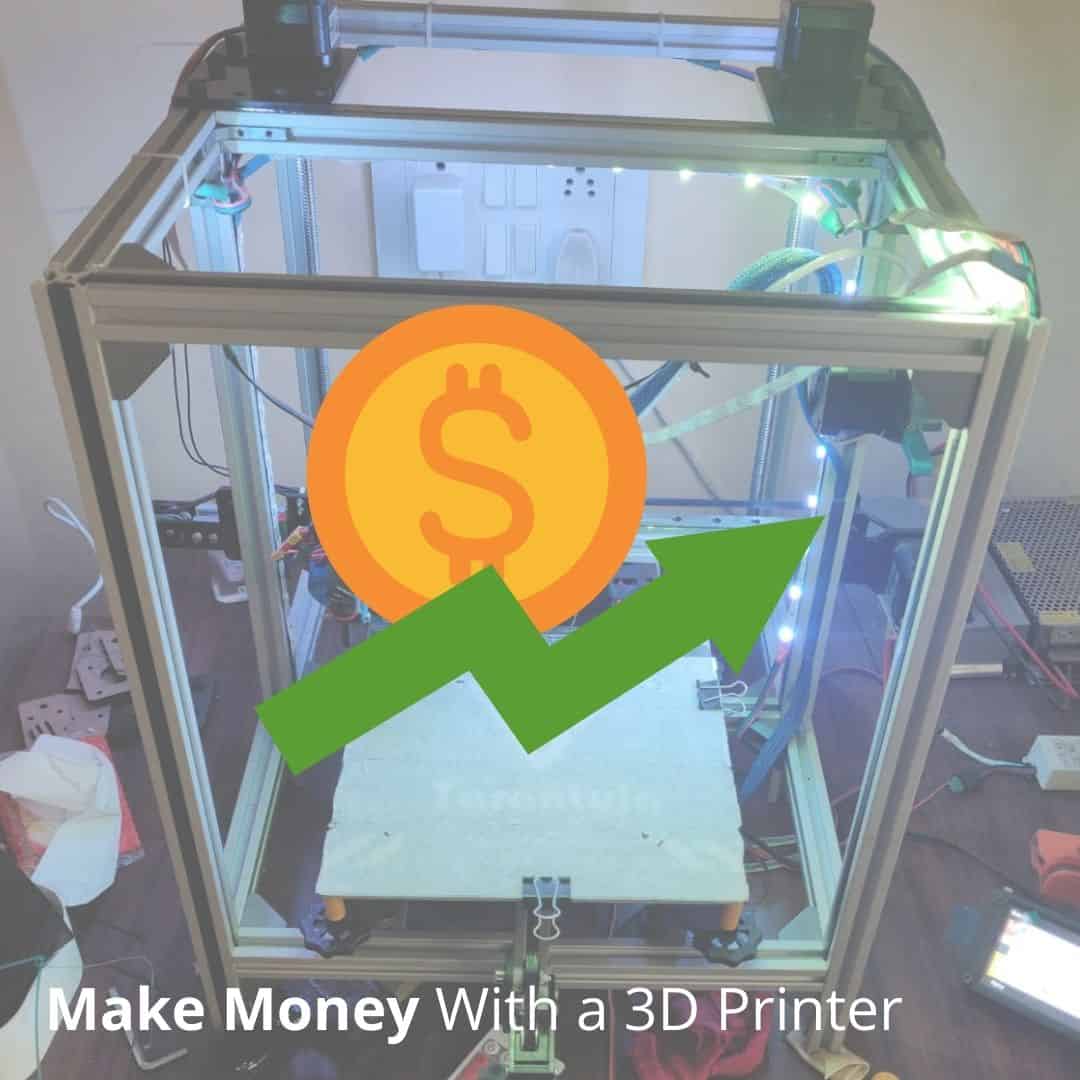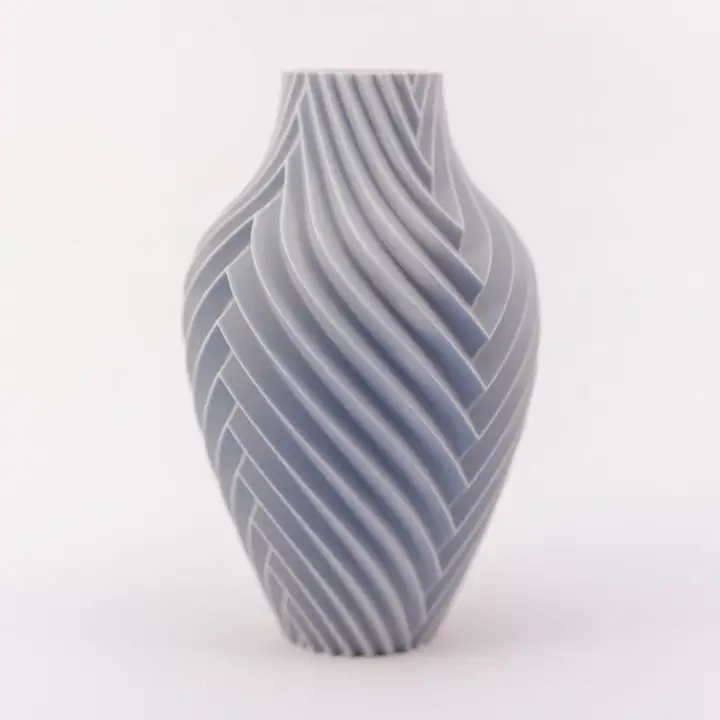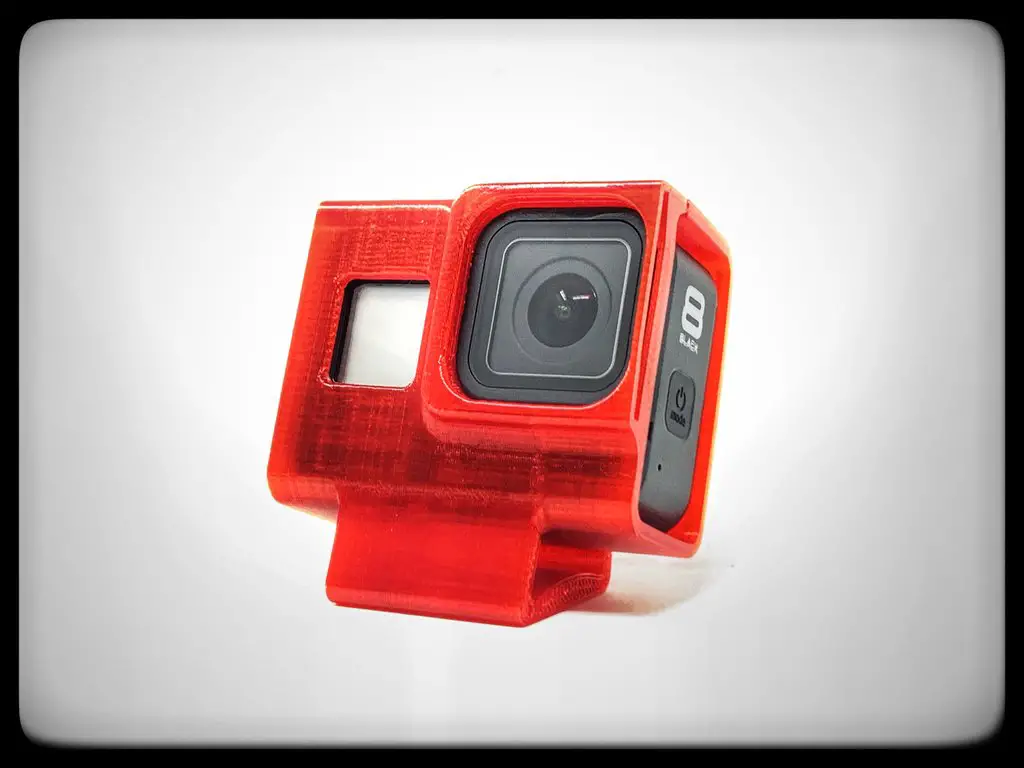With the power of 3D printing, it’s tempting to try and turn it into a side hustle. If you’ve got the technology to make things on demand, you can find people who are willing to pay for a service or product that you provide.
However, you can’t just buy a 3D printer, download free STL files from Thingiverse (or any of the 30+ alternatives we found), and expect the cash to start rolling in.
As with any business, it takes time and effort to get established and build a loyal customer base.
With that said, let’s check out the best ways to make money with a 3D printer. There’s a lot of ideas here, and I’ve tried to cast as broad of a net as possible to include something for everyone.
Table of Contents
- Best Ways To Make Money With a 3D Printer
- Offer print on-demand services
- Offer design services
- Offer consulting and troubleshooting services
- Start a YouTube channel
- Start a website
- Design phone cases
- Design home decor
- Print models for architects
- Print prototypes for inventors
- Print props for cosplayers
- Print and sell RC parts
- Print and sell personalized items
- Print and design jewelry prototypes
- Design and print game miniatures
- Print and sell lithophanes
- What’s the cost of starting a 3D printing business?
- Conclusion

Best Ways To Make Money With a 3D Printer
Offer print on-demand services
The first thing that comes to mind when you think about ways to make money with a 3D printer is to offer print-on-demand services.
There are plenty of online marketplaces like Shapeways where you can register your 3D printer and wait for orders to come in.
They work by letting you list your printer on their system, adding the types of filaments you print, and your price per gram of printing.
Then your listing goes live and customers can see your printer based on your location and the data you’ve entered. If someone wishes to work with you, they can upload their file, select you as their printer of choice, and you’ll get an order for a print.
Pros
- Print at your convenience
- Potential to develop long-term clients
- You get to print lots of different models
Cons
- Anyone with a 3D printer can sign up, so lots of competition
- Printers are really cheap so many people may just opt to get their own printer!
Offer design services
There’s a lot of potential in the 3D design industry as it is quite a specialized skill and it is in incredible demand. The industry is growing steadily, so that’s good in terms of long-term prospects.
3D design can range from very simple like hooks and brackets to quite complex like entire engines and mechanical parts! Once you learn the skill, the possibilities are endless.
Of course, owning a 3D printer does not make you a 3D designer right away – you need to go out and learn the skill! But chances are, if you’ve been printing for a while, you already know some 3D design.
To get started, I really recommend checking out Blender Guru on YouTube for some excellent tutorials.
You can offer your services on marketplaces like Fiverr and Upwork, and also offer to 3D print your designs as an upsell.
Pros
- Highly specialized
- Lots of growth potential
- Good skill to have for the future
Cons
- Steep learning curve
Offer consulting and troubleshooting services
As the owner of a 3D printer, I can tell you and you will agree that 3D printers are incredibly finicky pieces of equipment.
Troubleshooting a printer can be quite frustrating, especially if you are new.
Since you’re already so experienced, why not offer your troubleshooting services? You can charge by the hour and also take a small commission on any parts that you need to order.
You can also upsell teaching services from troubleshooting.
As a 3D printing consultant, you can certainly help individuals, but the real potential lies in targeting businesses that require 3D printers.
Architecture firms, manufacturers, real estate agents, furniture design companies, home decor companies all have uses for 3D printers but don’t necessarily have the time and resources to learn how to use them
Pros
- You can position yourself as an expert
- Can charge a premium rate
Cons
- May not scale well – you’re limited by the amount of time you can dedicate
Start a YouTube channel
You can document your experience with 3D printers on YouTube and build a following. YouTube channels are hard work, but the key is to consistently produce content that engages your target audience.
It will take a while to get traction, but if you keep at it, you can build a decent following and start a community.
You probably won’t make enough ad revenue to replace your income(you also need 1000 subscribers to start monetizing your videos), but you can certainly get a nice bonus amount every month.
Plus, YouTube opens the door for lots of other opportunities like films, affiliate marketing, and sponsorships.
If your channel gets popular enough, 3D printer companies may start sending you 3D printers for free to review 😉
Pros
- Low initial investment: you can shoot with your phone
- Fun to do
Cons
- Large time commitment
- Requires a huge following to really get good money
Start a website
There’s no shortage of people looking for 3D printing information on the internet. The same way you can answer these questions and provide information on YouTube, you can also provide information on a website in the form of written content.
This website is an example of just that!
I am a 3D printer enthusiast, and I decided to document my experience and knowledge online for you guys.
Starting a website is a great idea because it is comparatively passive. There is initial effort to set up the website, but once that’s done, the content is up there forever and can potentially earn for you for a long time.
Pros
- Comparatively passive
- Lots of potential
Cons
- Lots of effort
- Competition can be steep
Design phone cases
Mobile phones are an integral part of modern life, and by extension, so are mobile phone cases! It’s quite easy to design cases for popular phone models using TinkerCAD or Blender, and you can then sell them on marketplaces like Etsy or even on your own storefront using Shopify.
Try to 3D print your phone cases using TPU for the best durability and flexibility. PLA and ABS will be poor choices here.
To really hone in on an audience, keep your case designs aligned with a specific theme, and offer customization.
Pros
- Easy to design and 3D print
- Little time required
Cons
- Building an audience will be challenging
Design home decor

Home decor is one of those verticals in which 3D printers can really shine. Interior decorators can really let their creativity explode with 3D printed decor pieces.
For example, you can print your own custom lampshades, artwork, display pieces, customized brackets, frames, lithophanes, and so much more!
While it may seem overwhelming to try and establish yourself as a home decor seller, to start, you may wish to partner up with interior decorators in your area and offer your service as an add-on to them.
So next time they’re doing a project and need something specific, you can work together.
Pros
- Unlimited potential for creativity and designs
- Can partner up with established players in the industry
Cons
- You may need to expand your radius if you live in a smaller town
Print models for architects
Similar to the interior decorator idea above, you can pitch your 3D printing services to local architecture firms. Architects are always building models to present to their clients, and if you can automate a chunk of that process, it would make their life so much easier!
Call up local architects and offer your 3D printing services. Architects are already designers, so you just need to take their files, convert them to gcode, and start printing!
Architects don’t just build models of structures: their models include small parts like statues, trees, cars, bikes, people, and playgrounds, to name a few, all of which you can print away!
Pros
- Good opportunity to ride on a larger companies coattails
- Good potential once you are established
Cons
- You may need to expand your radius if you live in a small town
Print prototypes for inventors
In the earlier make money with your 3D printer suggestions, we looked at situations where you would either design or 3D print for people without much experience in the designing field.
For this side hustle, you’re going to find people who are already proficient designers: inventors and product developers!
3D printing is an incredibly important step in prototyping because it’s a cheap and quick way to see a physical version of your object.
Find companies that design and develop physical products and offer your prototyping services to them.
Pros
- Potential to fill a gap in the market: not all designers have the know-how or time for 3D printers
Cons
- You may need to really niche down to find a company to work with
Print props for cosplayers
Cosplay is a huge niche and comic book conventions are full of fans in cosplay gear. 3D printers are changing the cosplay game by letting you make incredibly life-like cosplay props like helmets, shields, swords, weapons, and more.
Why not offer your design and 3D printing services to cosplayers looking to blow everyone’s mind at the next convention? Instead of putting together props by hand, you can 3D print amazing props and costumes.
To get started, you can find cosplay forums and offer your services there.
Pros
- Lots of fun
- Can meet lots of new people
Cons
- May not scale well
Print and sell RC parts

The RC industry has probably benefited the most from the advent of 3D printers. Drones, airplanes, cars, and boats all need specialized parts and 3D printing has filled in that gap marvelously.
Some companies have even gone so far as to sell designs of 3D printable model airplanes!
Hang out on RC forums and see what kind of services are being offered there, and offer your services too.
Some companies like Brain3D sell their own line of exclusive 3D printed accessories for drones.
Hobbyists tend to spend a lot of money on their hobbies, so if you can offer something of value, there’s a lot of good potential.
Pros
- Hobbyists have big wallets
- RC is a fast moving industry and there will always be new things to print
Cons
- Competition may be stiff
Print and sell personalized items
3D printers are great for designing and making personalized gifts. You can customize pretty much anything for anyone, and it can be something as simple as a keychain or pendant to something unique like a personalized car accessory.
For inspiration, head to your local mall and pop into a personalization shop or kiosk to see what kind of stuff they’re selling. You can piggyback on their ideas to get started, or you can even partner up with them to offer your services as an upsell.
How cool would things like personalized 3D printed desk accessories, pen holders, phone stands, and the like be?
You can market your 3D printing business through Instagram, Pinterest, or even set up an online store on Shopify.
Pros
- Easy to carve out a niche
- Easy to position yourself in a unique position
Cons
- Must market very heavily
Print and design jewelry prototypes
An often-overlooked application of 3D printing is in the jewelry market. Especially when you consider custom-made jewelry, it’s so easy to design and prototype jewelry before actually getting it made with precious metals and stones.
Prototyping means you can actually wear the 3D printed model and see how it looks(even though it won’t have the colors), and it’s a great way to get an idea of how big or small this piece of jewelry will look on you.
As an aside, even if you don’t want to print the jewelry, you can certainly design it and play around with the design on the computer.
Pros
- Highly specialized
- High-ticket items mean potentially large commissions
Cons
- Must be proficient in design
- Small pieces of jewelry may be difficult to print
Design and print game miniatures
Tabletop gaming is huge: the board game market is worth an estimated $3.2 billion dollars. What does that mean? Remember that Monopoly piece you lost? Why not print yourself a new hotel?
Or what about that color of armies in Risk that your little cousin threw all over the house? Just print some new armies!
If you’re into D&D and tabletop games, the potential for those miniatures is also huge. As a business, it will be difficult to print copyrighted designs, but you can certainly come up with your own designs and miniatures.
There are plenty of D&D and tabletop games forums online where you can learn more about the games and introduce yourself and your services.
Pros
- Highly dedicated customer base
- Very wide variety of items to print
Cons
- You may run into copyright issues if you’re not careful
Print and sell lithophanes
Lithophanes are super cool 3D prints that you make from a photograph. A special software converts a flat photo into an STL file that you can 3D print.
The final print does not look exactly like the photo at first glance, but when you look at it in light, the photo will appear. Lithophanes make use of shadows and light areas to recreate the photo in 3D.
How awesome is that!
You can print flat, curved, or even spherical lithophanes. To market them, you can add a little LED light to make the image appear and disappear.
Lithophanes can be of general photos you took, or they can also be personalized from photos your customers send to you.
Here’s a guide to the best filament for lithophanes.
Pros
- Very easy to market
- Very low upfront cost
Cons
- Scaling is limited by the speed and size of your printer
What’s the cost of starting a 3D printing business?
Cost of a 3D printer
So you’re all hyped up and ready to start your 3D printing business, but you still need to get a 3D printer. What now?
Should you drop $1000 on a printer?
No way!
3D printers are incredibly cheap, and you can very easily get one for less than $300. Those will print decently out of the box, but with a few mods, you can get it printing really well.
I would not recommend getting a used 3D printer simply because it’s hard to tell how much use and abuse a printer has gone through. You may end up spending more money on repairing it and getting it back up than you would if you bought a new printer!
Our favorite budget 3D printer is the Creality Ender 3. For just around $200, it can’t be beaten.
Cost of filament
If you’re totally new to 3D printing, you’ll need to budget at least 2 to 3 rolls of filament to experiment and get your 3D printing skills honed in.
After that, you’ll just need to factor the cost of each print depending on how many grams the print comes out to.
Filament is usually sold in 1 kg spools, so it’s really easy to divide and come up with a cost.
Some slicer software like Simplify3D also lets you input the cost of your filament so when it shows you the final print weight, you’ll be able to see the approximate cost, too.
You’ll also have to factor in potentially failed prints. Every failed print is that much wasted filament, so price your services accordingly.
Electricity
An often-overlooked cost of 3D printing is the cost of electricity! Your 3D printer does consume power and if you’re going to run it for 10+ hours a day churning out prints, you’ll add a bit to your power bill.
Fortunately, 3D printers do not consume that much electricity, so even if you live in a place with a relatively high electricity cost, you can still price your services quite competitively.
Time
Finally, the last thing to factor into your prints is the time cost. A printer running for 12 hours means you can’t print anything else for those 12 hours, so you must consider your opportunity cost as well.
How long does it take to get established?
If you’re serious about making decent money with your 3D printer, you’ll have to stick with it and treat it as a proper business to get the ball rolling.
This means it’ll take a few months or longer of hard work to get yourself known and establish a customer base. This holds true for any business!
If you’re just looking to make a few dollars here and there, then just putting yourself out there and being in the right place at the right time can do the trick for you.
Conclusion
3D printers are amazing tools to make money and if done right, you can literally print money.
If you decide to go all in and feel that one printer is no longer enough to handle the volume of orders that you are receiving, then you may even have to invest in a print farm!


